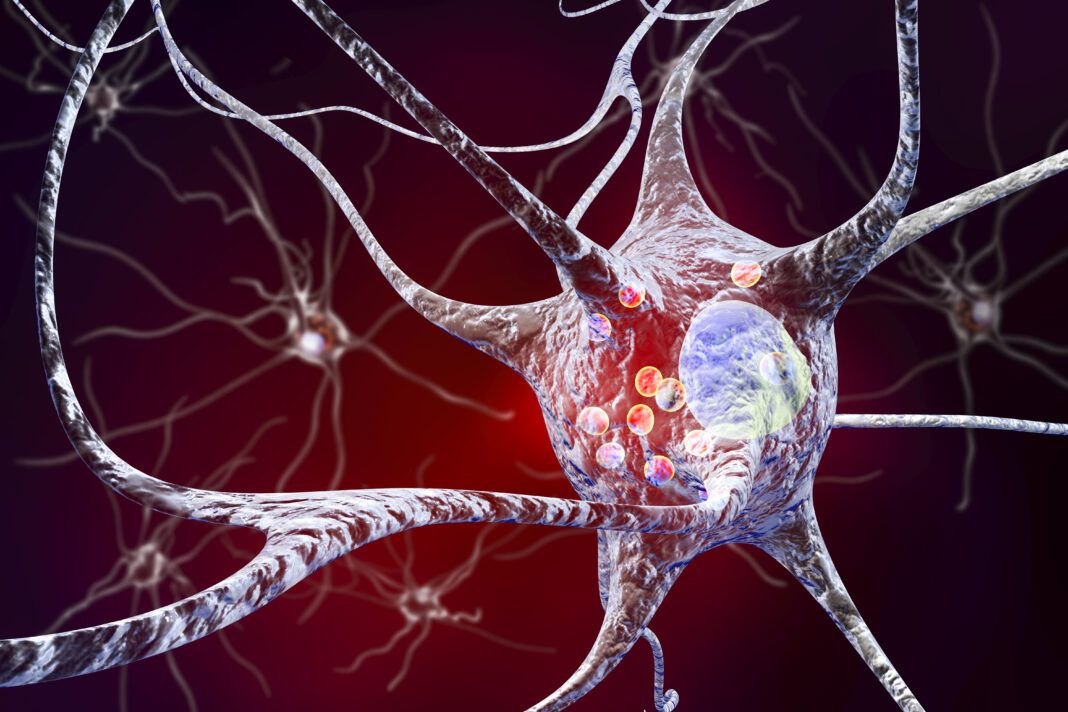Neurodegenerative diseases, such as Parkinson’s or Alzheimer’s, are associated with the deposition of protein aggregates in the brain. These aggregates accumulate when the cellular waste removal system is defective or overloaded. NEMO, a protein that is primarily associated with signaling processes in the immune system, prevents the deposition of protein aggregates that occur in Parkinson’s disease. Now, a research team led by Ruhr University Bochum has revealed how this mechanism works.
Their findings are published in Nature Communications in an article titled, “NEMO reshapes the α-Synuclein aggregate interface and acts as an autophagy adapter by co-condensation with p62.”
“NEMO is a ubiquitin-binding protein which regulates canonical NF-κB pathway activation in innate immune signaling, cell death regulation, and host-pathogen interactions,” the researchers wrote. “Here we identify an NF-κB-independent function of NEMO in proteostasis regulation by promoting autophagosomal clearance of protein aggregates. NEMO-deficient cells accumulate misfolded proteins upon proteotoxic stress and are vulnerable to proteostasis challenges.”
In collaboration with an interdisciplinary team, the Bochum-based research group gained a better understanding of the mechanism of ⍺-synuclein degradation: Cellular proteins that are destined for degradation are labeled so that the cellular waste disposal system can identify these proteins. This label consists of a chain of ubiquitin molecules. “Depending on how these ubiquitin molecules are linked and the length and structure of the ubiquitin chains, the cellular waste disposal system can recognize through which pathway the labeled proteins shall be degraded,” said Konstanze Winklhofer, MD, PhD, professor, Ruhr University Bochum.
In previous studies, the research group hasd shown that a specific form of ubiquitin chains, so-called linear ubiquitin chains, accumulates on protein aggregates in neuronal cells and reduces the toxicity of the protein aggregates. The researchers have now finally identified the mechanism of this protective effect. They found that the protein NEMO docks to linear ubiquitin chains on the protein aggregates and promotes the degradation of ⍺-synuclein.
“What’s interesting is that the protective effect of NEMO can be blocked by inhibiting autophagy,” explained Winklhofer.
The research group of Winklhofer discovered that NEMO interacts with a protein of the autophagy machinery. By forming a complex consisting of linear ubiquitin chains, NEMO, and the said protein called p62 on the ⍺-synuclein aggregates, p62 can be arranged in the form of condensates, which is essential for the efficient recruitment of the autophagy machinery to protein aggregates.
“A milestone during this research was a conversation with neurologists from the University of San Francisco, who had contacted me about an interesting case,” said Winklhofer. Her U.S. colleagues were treating a patient with progressive Parkinson’s disease who had fallen ill in her early 40s. They therefore ran a genetic test, which revealed that this patient had a rare mutation in the NEMO gene. “Our biochemical and cell biological characterization of the NEMO variant showed that it’s unable to bind to linear ubiquitin chains and therefore can’t dock to protein aggregates.” The loss of function of NEMO impairs the formation of p62 condensates on ⍺-synuclein aggregates and disrupts their degradation.
The research team is conducting follow-up studies to explore the potential of NEMO and linear ubiquitin chains for new therapeutic strategies.



